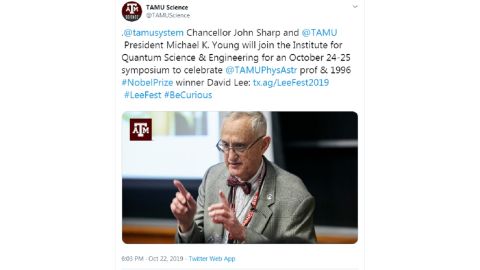
A Texas A&M physicist who has a Nobel Prize is now the national physicist of the year.
Dr. David Lee was recognized Thursday by the system chancellor and university president at the start of a two day symposium.
Nicknamed “Lee Fest”, the public is invited to attend short talks given by Lee’s colleagues through Friday at the Mitchell physics building.
Lee’s honor comes from the Top 100 Registry, which according to the A&M system, is a publication that features the most accomplished individuals from every industry and profession around the world.
Lee, who shared the Nobel with two colleagues at Cornell, is in his tenth year at A&M.
Click HERE to be directed to more information on the “Lee Fest” symposium.

Additional information from the Texas A&M system:
A Texas A&M professor – and the university’s only Nobel Prize winner – has been named the country’s 2019 Physicist of the Year.
David Lee, a distinguished professor of physics and astronomy, was honored Thursday on the flagship campus for being named the country’s top physicist by the Top 100 Registry, a publication that features the most accomplished individuals from every industry and profession around the world.
Texas A&M University System Chancellor John Sharp and Texas A&M University President Michael K. Young joined Lee and others for the recognition at the start of A&M’s Quantum Materials Science Symposium, which is also known more affectionately as Lee Fest.
Following the remarks from Sharp and Young, Dr. Lee recapped the Nobel Prize-worthy history of the discovery of superfluid helium-3 (He-3).
Dr. Lee is a member of the National Academy of Sciences (1991) and the American Academy of Arts and Sciences (1990). He earned his Ph.D. from Yale University in 1959 and took a faculty position at Cornell University, where he had enjoyed a prolific 50-year career prior to accepting a half-time professorial appointment at Texas A&M in November 2009. He is a member of the IQSE and was appointed as a distinguished professor of physics and astronomy in 2012.
Dr. Lee shared the 1996 Nobel Prize in Physics with fellow Cornell physicist Robert C. Richardson and Stanford University’s Douglas D. Osheroff — their doctoral student at Cornell at the time — for their 1972 discovery of superfluidity in He-3. During their days in the low-temperature laboratory at Cornell in the early 1970s, the three discovered, using a hand-built apparatus, that the helium isotope, helium-3, can be made “superfluid” — unaffected by friction — at a temperature only about two thousandths of a degree above absolute zero. This superfluid quantum liquid differed greatly from the one previously discovered in the 1930s and possessed highly specialized characteristics, illustrating that the quantum laws of microphyiscs also sometimes directly govern the behavior of macroscopic bodies. As a result of their breakthrough discovery, superfluid He-3 is now one of the richest systems in condensed matter physics, with exotic order parameters that exemplify a whole new set of physical concepts that impact many other areas, including even cosmology.
During the course of the trio’s Nobel experimentation, they also performed one of the first physics magnetic resonance imaging (MRI) experiments involving magnetic field gradients on the He-3 sample — imaging work applied to subsequent biological sampling techniques and later to the human body in disease detection and diagnosis. Lee has made many additional noteworthy discoveries during his 60-year career studying liquid and solid helium, including nuclear spin waves in spin-polarized atomic hydrogen gas. More recently, he has observed collective sound modes in superfluid He-3 that obey the Nambu identity and are analogous to the Higgs Phenomenon in elementary particle physics. Currently, Lee is actively engaged in studies of atomic free radicals trapped in low temperature matrices, including spin polarized hydrogen atoms embedded in the films of molecular hydrogen.
